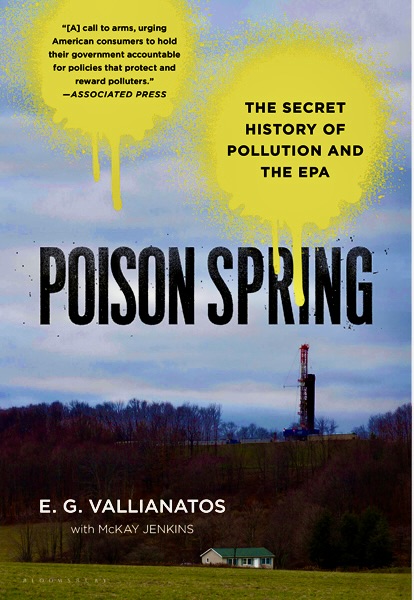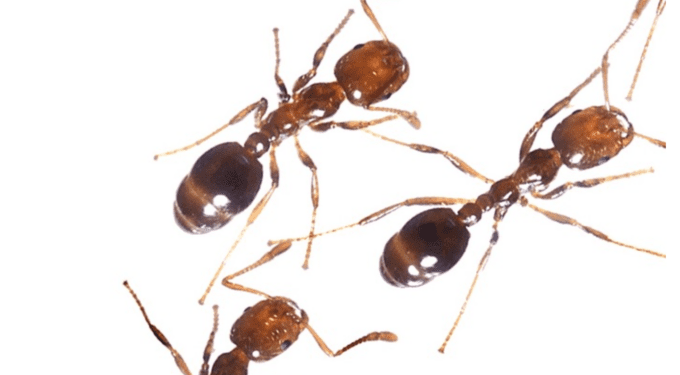Fire ants. Photo: Stephen Ausmus, USDA. Public Domain.
Origins
Like flees and rats that carried the bubonic plague to Europe from Asia in the fourteenth century, two of the four fire ant species arrived in the American south from southern Latin America. They did not carry diseases, but caused a plague of inconvenience to tractor-driving American farmers. Red and black fire ants were invaders, coming in offending ships in the midst of nursery plants and soil from Southern Brazil and Paraguay sometime in early twentieth century. In 1918, the black fire ants arrived in Mobile, Alabama. They colonized Alabama, Tennessee and Mississippi. The red fire ants (solenopsis invicta) were stowaways from Paraguay that jumped ship in Mobile, Alabama sometime in 1940. They spread to North Carolina and Texas.
How the red fire ants colonized the South
Without the natural enemies they had in Brazil, Paraguay and Bolivia, the red fire ants quickly built their homes in vast expanses of the American south. They built deep nests in the ground. These nests often became hard and caused trouble to farm machinery.
Fire ants are prolific. Once the colony reaches a certain population density, some members, male and female, take it to the air. This aerial display of biology and expansion usually takes place after rain in late spring and early summer. They fly and copulate at the same time, the males landing and dying. The females land and start digging holes in the ground, usually close to freshly cultivated land. Each of them, but separately, lay about 100 eggs in the first week. It takes about a month for each female to have enough worker ants to feed her. Then she practically becomes an “egg production factory.” In about a year, each colony starts producing ants with wings, ready to fly in the air and repeat the reproduction and the creation of new colonies. A mound may have as many as 250,000 red fire ants. The pioneering females responsible for these colonies become their queens.
Warrior red fire ants facing aggressive farmers
Fire ants are warriors. They are slightly larger than domestic ants, which they kill. In addition, they kill anything that is on their way, including beneficial and harmful insects, thus neutralizing their ecological services to agriculture. They eat honeybees, Monarch butterflies, parasitized aphids, parasitic insect pupae, lacewings and other beneficial insects. At the same time, fire ants eat insects that damage farm crops, including ticks, boll weevils, chiggers, sugar cane borers, and corn earworms.
Conventional farmers / growers rarely if ever think of beneficial insects, much less of the insects fire ants eat, which include insects that harm their crops. They are brainwashed. They are wedded to machines and chemicals. They don’t know and neither wish to know anything about growing food without machines and chemicals. Even more than machinery, pesticides are icons of American post-WWII farming. They are completely in control of the farmers’ mind. Misleading tradition and agricultural schools have been teaching them to associate pesticides with modernity, science, and food production. This means that farmers only see “pests” in the fire ants. They have to be controlled by all means possible. They ignore their beneficial effects and exaggerate the mythology of their nastiness: the alleged threat to humans, and their killing and eating of small pigs and calves. Thousands of farmers wrote letters to EPA against the imported “evil” red fire ants, why they had to be exterminated.
Yet, EPA said it was impossible to eradicate the red fire ants. They survived decades of chemical warfare because they are guerrillas, “easy to kill – and impossible to stop.” Farmers, however, did the usual thing, blasting the fearless red fire ants with their pesticides. They employed rigs and airplanes against them. They used every kind of deleterious substance in their ant wars, especially a DDT-like organochlorine chemical named mirex.
Chemical warfare
The mirex war against the red fire ants started in 1962, the year Rachel Carson published her critical pesticides study, Silent Spring. Farmers paid zero attention to Carson. They spent about $ 50 million in spraying mirex over more than 132 million acres of land.
Mirex was a deleterious substance like kepone. In fact, it degrades to kepone: an insecticide toxic enough to keep poisoning James River in Virginia since 1966. During that year, Allied Chemical workers dumped kepone into its waters. More than half a century later, James River was suffering from the kepone poisoning. It’s not safe eating fish from its waters.
Kepone and mirex are intimately related, being siblings from the same mother, a powerful chemical known as hexachlorocyclopentadiene. This is a precursor substance from which chemists synthesize several other chemicals.
Like kepone, mirex turned out to be extremely deadly and long-lasting in human tissues and the environment. EPA reported that mirex was responsible for “significant toxicity problems.” It is carcinogenic in rodents and, therefore, “may pose a cancer risk to man.” In addition, this is a toxic chemical. Its ecocidal effects include: “high persistence in the environment, accumulation in living tissues, and high toxicity to aquatic invertebrates.”
The decades-long and extensive aerial broadcast of mirex in the southern states did very little to prevent the expansion of the imported red fire ants, but it brought it in touch with millions of Americans. The poison contaminated air, water and food and, through them, lodged itself in human fatty tissues, including women’s breast milk.
In 1978, The National Academy of Sciences summarized the scientific evidence on mirex. In animal studies, mirex was a carcinogen, a potent poison crossing the placenta barrier for the fetal tissues, and a chemical responsible for giving cataracts to rats. Mirex resists degradation and metabolism, that is, it remains pretty much intact for a long period of time. It is very persistent in the environment, its half-life lasting from five to twelve years. Furthermore, It accumulates and biomagnifies in terrestrial and aquatic life. The higher the predator, the more mirex in its tissues.
In addition to its agricultural uses primarily in the south, mirex contaminated the entire country under the guise of a fire-retardant named dechlorane. We don’t know how much damage mirex has caused in America. But we do know it is toxic to humans. It is a DDT-like super poison that cripples and kills life in minute amounts – and keeps killing and deforming life for decades.
Farmers, however, loved DDT and loved the DDT-like mirex. They mixed it with corncob grits and soybean oil in order to make it palatable and tasty to fire ants. Sometimes fire ants gorged on the stuff, returning home and feeding it to their queens, thus poisoning their colonies.
Poisoning is never smooth or easy. In spreading mirex bait as widely as they could, farmers, exactly like they did with their careless use of the DDT silver bullet, they overreached and harmed much more than potentially the elusive fire ants. Mirex caused chaos near waters, killing indiscriminately grass shrimp, blue crabs, cray fish and other water animals.
The politics of EPA

US EPA logo. Public Domain
EPA used the carcinogenicity, toxicity, and longevity of mirex to convince farmers’ organizations it would be to the best interest of the farmers for the EPA to ban it. The “voluntary cancellation,” which started in 1975, was gradual and farmer-friendly. It became law on June 30, 1978.
Farmers, however, shouted foul and talked to their politicians who talked to the president of the United States and EPA officials to go easy with the mirex abolition.
Mississippi went further. It concocted a “new” red fire ant weapon by mixing mirex with some other poisons, but still having mirex as the principal active ingredient – the stuff responsible primarily for the poisonous effect. It called the new compound ferriamicide because of the ferrous chloride surrounding mirex. Mississippi claimed ferriamicide was not as bad as mirex because, under laboratory conditions, it broke down faster than mirex. This was clearly not true because of the supremacy of mirex in the ferriamicide complex.
Mississippi had constructed a monster chemical weapon from two banned pesticide chemicals, mirex and kepone. But to see results, the legal use of its illegal construction, it cashed in its political connections with the Carter administration. Mississippi insisted that EPA allowed it to replace “mirex” with “ferriamicide” (essentially the same stuff with different names) and spray it by aircraft over about 190 million acres of land and, necessarily, millions of people.
In the late 1970s, the political pressure on EPA was so intense that its officials started saying that fire ants were “hazardous to humans, livestock and wildlife” and, in addition, imported red fire ants were “a severe pest problem.” These imported red fire ants caused “economic damage” to the farmers. EPA, however, insisted Mississippi had a long way to go before proving ferriamicide was less dangerous than mirex.
Mississippi, EPA said, has shown that the breakdown products of ferriamicide are “acutely less toxic to crabs, grass shrimp and cray fish. We know nothing of their chronic toxicity to fish, wildlife and man.”
Pork barrel politics
An anonymous federal government official accused the managers of the fire ant control program in the southern states for indulging in straightforward “pork barrel” unrelated to fire ants. Fire ant wars allow local southern politicians, the government official said, to “make jobs, launch fleets of spray planes and get up at the Fourth of July picnics and tell everyone that without us to get rid of these ants you would not be here.”
Jim Buck Ross, Commissioner, Department of Agriculture and Commerce, Mississippi, and Barbara Blum, Deputy Administrator, EPA, were the protagonists in the fire ant wars in the late 1970s, especially during 1978, the second year of the Jimmy Carter administration. They influenced the science and politics of what to do with the greatly magnified “damage and hazards” of the imported red fire ants. All politics went through them. They imagined the problem and funded and influenced the solution.
Ross and Blum addressed each other by first name. Each time Ross arrived in Washington, DC, he had lunch with Blum. Ross insisted EPA should play the farmers’ game and allow the emergency use of this unknown toxic bait, ferriamicide, that included the banned mirex and kepone. Southern Senators, especially James Eastland of Mississippi and Herman Talmadge of Georgia, kept reminding and threatening EPA that it could not let farmers down. It had to approve the use of ferriamicide. Senator Ted Kennedy of Massachusetts and Congressman John Moss of California, however, raised objections to the requested air spraying of the untested and toxic mirex.
Even Blum was not impressed – at least temporarily — by the bullying of the southern Senators. On February 14, 1978, she sent a “ferriamicide memo” to Steve Jellinek, the political appointee who run the pesticides empire of EPA. She told Jellinek that, essentially, a grant of $ 160,000 from EPA to Mississippi was funding Mississippi’s efforts to find a “solution” to the fire ant problem. Yet, she had doubts EPA could approve ferriamicide without the necessary toxicity data. In addition, she said:
“[T]he political problem underlying the intense Congressional pressure is due to the $ 10,000,000 Federal / state program for [the proposed] aerial application [of ferriamicide] and the need to commit state dollars before the southern legislative recess for the year.”
In a February 22, 1978 memorandum for President Jimmy Carter, Barbara Blum repeated and expanded the concerns she revealed to Jellinek. Southern politicians and governors were for ferriamicide, Eastern politicians were against the mirex-like chemical. Moreover, she said to Carter EPA was inundated by more than 20,000 letters “overwhelmingly supporting the Ferriamicide application.” We don’t know, she said, if this chemical “is or is not safe for humans, domestic animals and nonaquatic species.”
Blum hinted that a federal investment of more than $ 96 million in fire ant control programs since 1957 probably motivated the members of the southern Congressional delegation to go on wishing more of the federal giveaways for fighting fire ants with pesticides like ferriamicide. However, she said to Carter that it was unlikely that EPA would approve the aerial use of this chemical, ferriamicide, thus displeasing the southern Congressional delegation.
Nevertheless, pork barrel politics triumphed. “I recommend granting a specific exemption for use of Ferriamicide for mound-to-mound application and limited ground broadcast application,” Jellinek said to Blum. She agreed and signed the Jellinek memo the day she received it, March 8, 1978. Essentially, she (and the EPA) blessed the demands of the southern Congressional politicians and lobbyists for the perpetuation of the war on the red fire ants. The next day, March 9, 1978, EPA officially approved ground use of ferriamicide in nine Southern states.
The only serious objection to this dishonest and dangerous policy came from EDF: the Environmental Defense Fund, a private, nonprofit, national environmental organization that played a leading role in the banning of mirex.
William Butler, EDF general counsel, denounced EPA for its bad science and even worse political decision to resurrect the banned mirex and kepone in the form of the untested and unregistered red fire ant poison ferriamicide. Butler said the massive federal-state program of fire ant control has “totally failed to prevent the spread of the ants.” Thus, “the cure (of the widespread dissemination of the extremely potent and lasting poisons mirex and kepone) is worse than the disease (red fire ants inconveniencing Southern farmers). Butler cited a 1972 report of the National Academy of Sciences describing the red fire ants as nuisance to the farmers.
Butler accused EPA for encouraging a paradigm shift in science and regulation: the delusion of using the pesticide first and testing its effects later. “[W]e have learned little,” he said, “that the cycle is to begin again, and that it is business as usual for the federal pesticide regulation.”
Butler hit the nail on the head. The Office of Pesticide Programs of the EPA, like a faithful dog of the industry, has been wagging its tail to agribusiness. It has learned very little if anything of science and the protection of public health. Pesticides business as usual has been its overwhelming and defining mission.
A “Note” from that poison age of the late 1970s reveals the depths of corruption and fear at EPA, entirely in the cold embrace and mercy of the agribusiness industry. The time was September 1978, six months after EPA licensed the ground use of ferriamicide in the south. Two senior EPA administrators, Bill Murray and Edwin (Ed) Johnson, were the protagonists in the drama of doing something or nothing about the hot potato of ferriamicide.
Murray was division director. I never met him, but from fragments of the memoranda / notes he authored, and which came to my attention, he was a straightforward scientist-administrator. He did not beat around the bush. On September 13, 1978, he sent a note to Johnson, deputy assistant administrator of the Pesticide Programs. Murray was in charge of a few laboratories serving the regulation of pesticides. One of his lab scientist, Dr. Chen, was testing ferriamicide, very possibly to find out if it was a carcinogen just like mirex from which it originated.
I knew Johnson, the real boss of the Pesticide Programs. He was shrewd and diplomatic. He knew who buttered his bread. He stood on the side of the industry. He called Murray and expressed his doubts about the timeliness and focus of the testing of ferriamicide by Chen.
Murray respected Chen and had confidence in his talent and integrity. He said to Johnson:
“Your stated concern was that the resultant data [from Dr. Chen’s testing of ferriamicide] might not be appropriate to the sensitive situation that we will have with this particular replacement of mirex. I sensed that you felt that our data might not make the case for which it was originally requested by the Registration Division; indeed, that it might be deficient. I understood your concern completely and have talked with Dr. Chen in some detail about his work. I am concerned both with your point and also with the very possible result that Dr. Chen may feel that there is a lack of confidence in his work…. I am suggesting that until his [comprehensive and reliable] work is ready for peer review, it will not be made available to anyone…. I believe that Dr. Chen’s considerable care and professional approach to his work and the arrangements to be made for validation through the use of peers will assure you of usable data for decision-making. On the other hand, if after considering the above facts you feel that you want the work stopped, then you should so advise us immediately.”
I don’t know if Johnson responded to Murray in writing. I don’t even know if Chen completed his study of the toxicity of ferriamicide. In all likelihood, he did not. But I do know it made no difference to the ambiguous and political pesticide policies of EPA. In 1979, Eula Bingham, a Carter administration Assistant Secretary of Labor in charge of the Occupational Safety and Health Administration, criticized EPA’s ferriamicide decision. We learn that, in July 1983, EPA turned down Mississippi’s demand for the legalization of ferriamicide.

Epilogue
The story of the imported red fire ants illustrates the unwillingness of the EPA, the US government and society, to defend public and environmental health. The unbridled capitalism of the farmers of the South, ignored the public interest for their delusions of short-term economic interests. They insisted they and the government had to wipe out the red fire ants. However, the scientific evidence was clear. Mirex, kepone, and ferriamicide were dangerous to both wildlife and humans. And yet, both misinformed farmers and their political leadership insisted that EPA should stop testing ferriamicide and approve its use by issuing emergency exemption from the law. Corruption at EPA did the bidding of the farmers, but not for long. At the end, in 1983, EPA forbade anymore spraying of the deadly ferriamicide.
There are countless stories like that of the imported red fire ants. I summarized my knowledge from my 25-year experience with EPA in my 2014 book, Poison Spring.
At a time of climate chaos, Americans must protect our precious natural world and our health. Create an EPA immune to influences from the industry and politicians. Make the EPA a Department of the federal government. Americans should vote for the head of the EPA, thus giving the Department of Environmental and Public Health Protection political independence. The Federal Reserve might have clues for the independence of such a resurrected EPA.
NOTES
1. James P. Sterba, “Fire Ant Insecticide is Center of Dispute,” New York Times, December 7, 1977. ↑
2. “Biology of the Imported Fire Ant,” Registration Division, Office of Pesticide Programs, EPA, June 6, 1978. ↑
3. S. Bradleigh Vinson, “Invasion of the Red Imported Fire Ant,” American Entomologist, Spring 1997, 23-39. ↑
4. Jan Reid, “Texas Primer: The fire Ant,” Texas Monthly, June 1986. ↑
5. Tamara Dietrich, “VIMS: Kepone could soon be history in the James River,” Daily Press, July 8, 2017. ↑
6. “Section 18 – Action Memorandum: From Steven Jellinek, assistant administrator for Toxic Substances, to Barbara Blum, deputy administrator, EPA, March 8, 1978. ↑
7. National Research Council, Kepone / Mirex / Hexachlorocyclopentadiene: An Environmental Assessment (Washington, DC: National Academy of Sciences, 1978), 34, 7-14, 38-39. ↑
8. Action Memorandum from Jellinek to Blum, March 8, 1978. ↑
9. “Anticipated Questions and Answers – Ferriamicide Exemptions [and] Additional Questions and Answers,” Office of Pesticide Programs, EPA, [1978]. ↑
10. Action Memorandum from Jellinek to Blum, March 8, 1978. ↑
11. Environmental Defense Fund, News Release, March 9, 1978. ↑
12. Ward Sinclair, “Chief Job-Safety Enforcer Joins Pesticide Foes,” Washington Post, February 19, 1979. ↑
13. Robert Sangeorge, “Fire ant poison use rejected by EPA,” UPI, July 1, 1983. ↑
Source link : http://www.bing.com/news/apiclick.aspx?ref=FexRss&aid=&tid=66f24c7e750c4ae38cb297482f78d431&url=https%3A%2F%2Fwww.counterpunch.org%2F2024%2F09%2F24%2Fred-fire-ant-wars%2F&c=10642853428618322994&mkt=en-us
Author :
Publish date : 2024-09-23 17:55:00
Copyright for syndicated content belongs to the linked Source.







